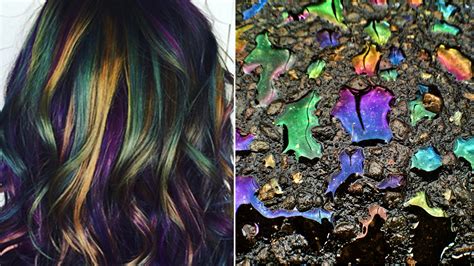What Makes Oil Slick Colors So Captivating?
Oil slick colors, with their iridescent hues and ethereal shimmer, have captured the imagination of artists, designers, and scientists alike. These mesmerizing effects arise from the intricate interplay of light with thin layers of oil on water, known as thin-film interference.

As light passes through the oil layer, it undergoes multiple reflections and refractions, creating constructive and destructive interference. Constructive interference occurs when light waves align in phase, amplifying their intensity, while destructive interference occurs when waves cancel each other out. This interference pattern results in the vibrant colors and iridescent shimmer characteristic of oil slicks.
Applications of Oil Slick Colors
The mesmerizing beauty of oil slick colors has led to a wide range of applications across various fields:
-
Art and Design: Artists and designers have harnessed oil slick colors to create stunning paintings, sculptures, and jewelry. The iridescent effects add depth, texture, and visual intrigue to their works.
-
Cosmetics and Fashion: Oil slick colors have made their way into cosmetics, such as eyeshadows, lipsticks, and nail polishes, creating captivating and otherworldly looks. In fashion, shimmering fabrics inspired by oil slicks have become a trend in clothing and accessories.
-
Industrial Applications: Scientists have explored the use of oil slick colors in anti-counterfeiting measures. The unique and complex interference patterns can be difficult to replicate, making them a valuable tool for protecting valuable goods.
Technical Aspects of Oil Slick Colors
The colors observed in oil slicks depend on the following factors:
-
Film Thickness: The thickness of the oil layer influences the wavelength of light that experiences constructive or destructive interference.
-
Refractive Index: The refractive index of the oil determines how light bends as it passes through the film.
-
Incident Angle: The angle at which light strikes the oil slick affects the interference pattern.
Mesmero: A New Material Inspired by Oil Slick Colors
Researchers at MIT have developed “Mesmero,” a novel material that mimics the iridescent effects of oil slicks. Mesmero is a thin, flexible film composed of alternating layers of transparent and metallic materials. By precisely controlling the thickness and composition of each layer, researchers can tailor the optical properties of Mesmero to create diverse color effects.
Tables on Oil Slick Color Applications
| Industry | Application |
|---|---|
| Art | Paintings, sculptures, jewelry |
| Cosmetics | Eyeshadows, lipsticks, nail polishes |
| Fashion | Shimmering fabrics, clothing, accessories |
| Technology | Anti-counterfeiting measures |
Common Mistakes to Avoid with Oil Slick Colors
To achieve the desired effects with oil slick colors, avoid the following common mistakes:
-
Overusing: Excessive use of oil slick colors can overwhelm a design, creating a chaotic and disorienting appearance.
-
Poor Lighting: Inadequate lighting can diminish the impact of oil slick colors. Natural or indirect lighting often produces the most flattering results.
-
Ignoring the Context: Consider the overall style and context of a design when incorporating oil slick colors. They should complement rather than clash with other elements.
Conclusion
Oil slick colors have captivated humans for centuries, inspiring creativity and innovation. Their iridescent hues and mesmerizing shimmer continue to find applications in art, design, fashion, and technology. With the advent of novel materials like Mesmero, the possibilities for exploring and utilizing oil slick colors are endless.
